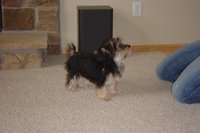The highlight of the trip, for me anyway, may have been the finish. Hiking into a remote village at the end of a two week trip is exciting. You can almost smell the non-dehydrated food and feel the warmth of buildings from miles away. I felt like I was racing to the finish line as we approach the village.

Yet I was a little nervous, I wasn't sure what to expect of Anaktuvuk. At first I felt like an intruder, and I knew that many of the villages in Alaska are known as being rough and not very accepting of outsiders. That was certainly not the case here. The people of Anatuvuk were incredibly friendly. I lost track of how many people on the street came up to us and started talking, asking us about our trip, talking about the upcoming caribou migration, explaining how to make Eskimo band-aids. Caribou soup was being served at the community hall and we were invited to eat some. We were also told that we could come back any time, that they always like having visitors. If only I could get a glaciology position in Anaktuvuk...
The people of Anaktuvuk are Nunamiut Eskimos (inland Eskimos) with a culture very different from the Inupiaq Eskimos (coastal Eskimos). They were a nomadic group that subsisted primarily on caribou and other small game. Supposedly they were the last nomads in North America to "settle down" - Anaktuvuk was not formed until the 1950s. Its amazing to think of the changes that have occurred to these people during the last 50 years. They now have indoor plumbing, oil heating, and regularly scheduled flights bringing mail and food. They still maintain much of their subsistence ways, but have sadly all but lost their language. Very few people younger than 50 speak Eskimo. Even though almost everybody there speaks English as a first language, they do so with an accent that makes you feel like you're talking to people who speak English as a second language. We were told that the children learn Eskimo in school, but they have little incentive to use it on a daily basis, so what they learn is quickly lost.

Anaktuvuk is isolated, but the people living there certainly are not. Many visit Fairbanks a few times a year, and some are quite worldly. One person we met said that he went to boarding school in Oregon during the 1960s (it used to be that all Alaska natives were sent to boarding school far from home, to Mt. Edgecumbe in southeast Alaska, Oregon, or even Oklahoma!). After boarding school he enlisted in the military because he had a low draft number and would have been drafted anyway. He just narrowly avoided being sent to Vietnam (he loved Nixon because of that), but instead spent several years in Germany. During that time he traveled around and saw many places in Europe. I could sit and listen to him tell stories for hours. Actually, many of the people there were good storytellers; telling stories is an important part of their culture, as they didn't have written language until recently.









